|
By Jerry Tardif
Editor's note: This article is published in the May 2008 issue of "Perfect Horse" magazine — several additional photos have been added.
"Perfect Horse" also has articles about many other important aspects of horses, training, and their care — check them out!
Most horses love going out on the trail.
It's a nice break from the usual training regimen.
However, stepping outside the box brings its own set of hazards and challenges.
Deer, bears, quail, skunks, and other denizens of the trail are rare in the arena, so horses acclimated to a more controlled environment may spook and act unpredictably on the plains or in the forest.
Even seasoned trail horses are occasionally surprised by wildlife, bicycles, kids with kites, barking dogs, and other chance encounters.
Does this mean you should avoid the trails.
Of course not.
But it does mean you should be prepared for any eventuality.
No matter where you ride, it's always a good idea to wear a riding helmet.
On the trail, the ground can be even harder than in a groomed arena.
The addition of rocks and logs can make a fall even more dangerous — while slippery footing may increase your chances of hitting the ground.
Trees, too (also rare in the arena), present perils to riders who "blaze" trails through the brush or happen not to notice the occasional low hanging branch.
A helmet protects your head from such encounters and shelters you from the sun, wind, cold, and rain.
While you may need a well-ventilated helmet for hot, summer riding, don't give in to the temptation of foregoing a well-fitting helmet all year-round.
Don't overlook the importance of wearing appropriate footwear, either.
Riding shoes and boots are designed to provide good traction while walking, but with a tread and heel that won't allow your foot to get hung up in a stirrup.
If you think it would be bad to get dragged in an arena, it's unthinkable what it would be like being dragged by a spooked horse for half a mile.
So, you should avoid sneakers.

|
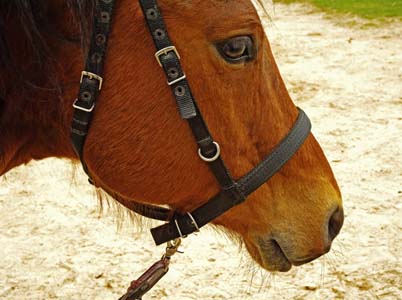
All Photos By Jerry Tardif
|
|
Think "multiuse" — Jerry uses a halter/bridle to makes thing easy.
At left, he's added scissor clips to the ends of his reins and uses them to connect to the bit.
At right, Jerry has pulled the bit and now uses his reins as a lead line.
While Jerry eats lunch on longer rides, this makes it very easy to let his horse graze, but without a bit in his mouth and the hassle of bringing along a separate lead line and a halter or collar.
|
With trail riding, it's all about options.
Since you don't know what you'll run into or what you'll need, you want to be as comprehensive as possible without loading your horse down like a moving van.
The more items that can do double-duty, the more options you have with no additional weight.
So, think multiuse for the gear and tack you carry.
For example, on my horse, I use a halter/bridle combination.
The reins connect to the bit using scissor clips.
I can unclip the reins from the bit, clip one end to the halter ring, and remove my horse's bit.
Then I can hold the other end of the reins as a lead line while he grazes and I eat a sandwich.
What about getting lost.
A horse is often thought of as "a living map".
His outstanding memory affords him the ability to remember where he's been.
He usually knows his way back to the barn even if you don't.
But horses, too, can sometimes get confused.
Trailering to a new location often means your horse is in a completely unfamiliar locale.
This is when is pays to carry a map of the area, a compass, and the ability to use both.
A GPS is also a fine tool and I carry one of those too, but electronic devices sometimes break, fail, or their batteries run down, so I carry the map and compass as a low-tech, but reliable backup.
Although a riding friend often teases me that I'm riding my "living map", I've taken my own tumbles and realize I could find myself separated from my horse in an unfamiliar environment.
For that reason, I carry my cell phone, GPS, and my map and compass on my person (I don't think my horse will use any of them if I leave them in his cantle bag and we get separated).
My GPS is also a walkie-talkie and acts as a backup to my cell phone in case there's no signal or it gets damaged in a tumble.
Remember, go for multiuse.
Even though I carry those critical items on my person, I still make good use of my cantle bag for other items that are handy to have on the trail.
For example, I carry a hoof pick, a first aid kit I can use on myself and my horse, and a multi-purpose tool that includes a knife, pliers, cutters, screwdriver, and awl.
I carry several "kits" that are each contained in their individual plastic zip bags.
This keeps them together by function (first aid kit, signaling kit, sewing kit, fishing kit, etc.).
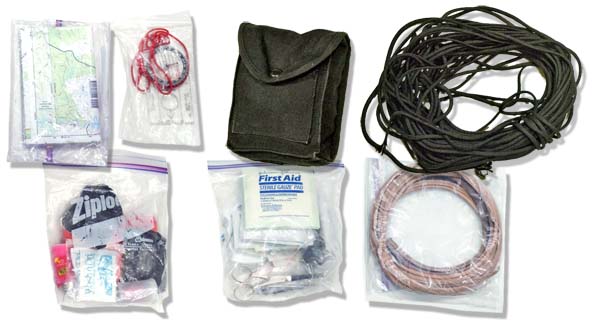
|
|
A sampling of individual kits includes: map and compass; a canvas bag containing a signaling kit of heavier items, such as a flashlight (with separate batteries), matches/candle, signaling mirror, strobe light, whistle; parachute cord; personal comfort kit with hand cleaning wipes, Trioxane heat packets, poncho; first aid kit; strips of leather.
|
I also carry some strips of leather and 50 feet of parachute cord.
The cord is light, takes up little space, and can be used as a makeshift lead line or to make an emergency bridle, reins, or both.
And a strip of leather can be fashioned into a temporary bit.
While you may not think your well-maintained headstall, bit, or reins will come loose or break, you don't want to be one of those rare statistics who ends up miles out on the trail with no plan or workaround.
Two people I rode with last year had bridles break during our ride — it really does happen!
Year round, I carry a one-quart canteen when riding in any weather.
I find myself thirstier in the summer, but it's just as easy to become dehydrated when you're out in the cold, dry air.
Taking a canteen also means I have clean water available for cleaning cuts and wounds on myself or my horse.
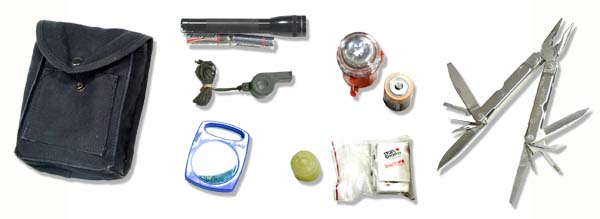
|
|
The signaling kit includes a strong canvas bag to hold it all; flashlight and batteries; a whistle; signaling mirror; strobe and battery; and a candle and matches.
The multipurpose tool is stored in this kit because the strudy bag keeps it from sliding around.
|
In addition, there are items I carry in the event of getting lost or an emergency.
I carry a flashlight with fresh batteries and keep them separate so I can't leave the light on accidentally and drain the batteries.
I include matches and a candle (in case I have to heat something or light a fire), a mirror for daytime signaling, a small weatherproof strobe light for nighttime signaling (with flashlight as a backup), and a whistle.
I call this my "signaling kit" and store all the items in a canvas pouch for additional strength, since some of these items, especially the batteries, are heavy.
Additional items are for personal comfort: I dress in layers so I can adapt to weather changes and pack an emergency poncho to keep the rain off.
The poncho goes down to my knees, includes a hood, and comes folded at a small size of 5" x 3.5" x 0.5" thick.
I carry several packets of pre-moistened sanitized hand wipes (nice to use after cleaning hooves and before eating my lunch out on the trail).
And two compressed trioxane packets can provide sustained heat for warming a meal or boiling water — you can find them at any Army/Navy surplus store.
They light easily with a match and will heat for about nine minutes.
They're also cheap, compact, waterproof, and remain usable for years.
A small sewing kit contains needle, thread, and safety pins.
I've never sewed out on the trail, but I've been glad to have some safety pins along on several occasions to quickly deal with a tear in a shirt that got caught on an errant branch or was the result of an unplanned tumble (are any of them truly, ever planned?)

|
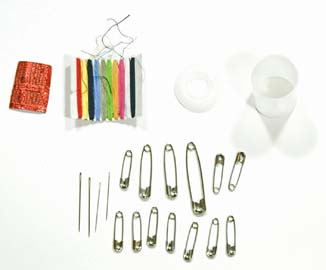
|
|
Whether you carry a compact pick or one with a brush, when trail riding, a hoof pick is an indispensable tool
|
Jerry admits he doesn't do much sewing out on the trail, but the safety pins have certainly come in handy a time or two.
|
I'll also be adding a few more items to my cantle bag this year.
For example, I'll be adding a hoof-boot in case my horse throws a shoe miles from home.
I want one that's not right or left-foot dependent so I can carry only one and use it on any hoof.
I'll also pack a small, roll-on insect repellent to foil annoying bugs.
(DO NOT carry a pressurized spray can — it could overheat and burst).
"So," you may be thinking, "Jerry carries lots of junk he'll likely never use".
I may not use all the items I take, but I don't know which I'll need until some "event" occurs.
I've certainly been glad to have bandages for cuts and bruises.
I've used the multi-purpose tool several times to tighten or adjust loosening or recently damaged tack buckles, D-rings, and such.
I've used the hoof pick after going through thick mud and to remove rocks stuck in shoes.
The flashlight came in handy when I returned from a ride later than expected and darkness had already set in.
I've not needed the map to get home, but have referred to it frequently out on the trail to find shorter or alternative return routes when a planned route was blocked, washed out, or unexpectedly closed.
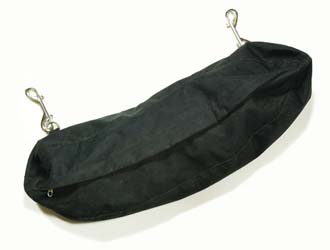
|
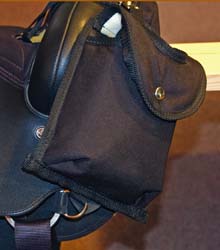
|
|
Above left: Jerry's cantle bag holds a variety of "kits", but the complete package weighs only 4 pounds.
Above right: Jerry afixed a footman's loop to the front center of the cantle for his canteen.
He then secured the bottom of the canteen pouch to his cinch ring with velcro so it doesn't bounce when he canters or gallops.
|
Frankly, it's been comforting to be able to handle unexpected events on the trail with minimal inconvenience.
My trail kit is small, light (4 pounds excluding the canteen), and comprehensive enough to cover most eventualities — that's not much for my peace of mind.
Fortunately, serious trail injuries and problems are not very common.
But when one happens to you, the statistics don't matter one bit.
Having a plan, some basic materials, and a few simple tools with which to work gives you options that can make your ride safer and more comfortable
Besides being an avid trail rider, Jerry Tardif is a technology consultant and a horse and nature photographer in SE Connecticut — see his work at: www.jerrytardif.com.
He is also co-founder and President of QueryHorse.
Back to Article Index
|